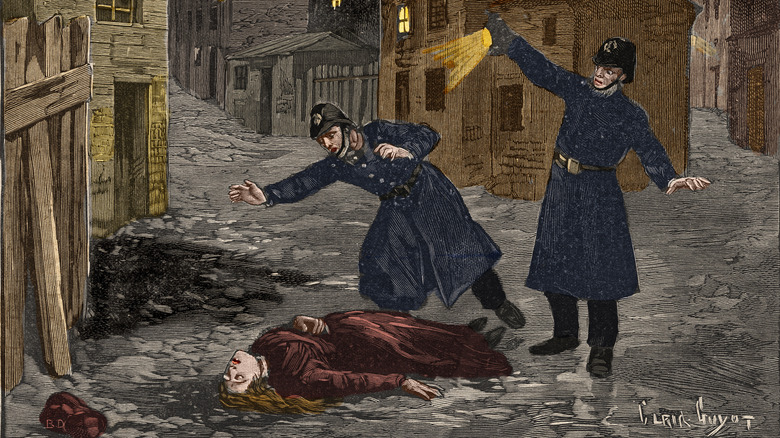How DNA Evidence Finally Exposed The Potential Identity Of Jack The Ripper
The case of Jack the Ripper is perhaps the most infamous unsolved crime in history. Against the backdrop of Victorian London's impoverished Whitechapel district, an unknown killer murdered and mutilated five women, targeting vulnerable victims with histories of sex work and alcoholism. The year was 1888, and investigators, lacking the forensic technologies of today, were left clueless. In the nearly 150 years since the murder spree, countless sleuths both professional and amateur have tried to retroactively determine the identity of Jack the Ripper. A breakthrough in DNA evidence may have done just that.
In 2007, historian Russell Edwards purchased a shawl thought to be the only piece of physical evidence from the Whitechapel crime scenes to have survived to the present. It belonged to Catherine Eddowes, the fourth of the five canonical victims, and is stained with both blood and semen. Edwards subsequently passed the shawl off to a molecular biologist to run DNA tests on. In 2014, the researchers announced that they had found a 100% match with one of the prime suspects in the murders: one Aaron Kosminski.
Kosminski was a barber born in Poland, who had settled in England six years prior to the Whitechapel murders. At the time of the killings, he was 23, and shortly thereafter he was hospitalized multiple times for psychiatric issues. After threatening his sister with a knife, he was committed to an asylum where he died in 1919. It's easy to see how Kosminski became a suspect, but forensic experts have cast serious doubts on this theory.
Don't put too much faith in these findings
The initial 2014 report claiming to have matched Jack the Ripper's DNA to Aaron Kosminski was widely criticized because the findings were not peer-reviewed, and moreover were published in a tabloid: The Daily Mail. The researchers responded by conducting further tests, this time with the help of descendants of both Kosminski and Eddowes. Mutations in DNA can be passed to offspring, creating lineages of similar genetics, so when the DNA from the shawl was matched to Kosminski's relatives, it seemed to bolster the argument. These results were published in the Journal of Forensic Sciences, but they again came under fire.
Specific details regarding the gene variants compared in the samples were not provided in the study, something that the researchers claim was done to protect the privacy of Eddowes and Kosminski's relatives. The results relied on mitochondrial DNA — DNA which is found inside the mitochondria of cells — but some forensics experts have argued that mitochondrial DNA tests can only reliably determine when samples are not related, and that there could be thousands of other matches for the DNA presented.
DNA is often the best evidence that crime scene investigators have to go on, but with a case over a century old, even DNA is difficult to rely on. Of all the holes in this theory, the most glaring issue is that the shawl is question can't even be confirmed to have come from the crime scene. It may never have belonged to Catherine Eddowes at all.

